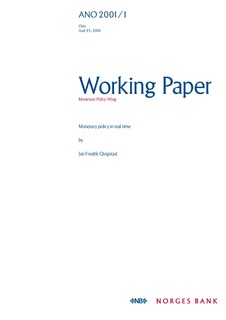| dc.contributor.author | Qvigstad, Jan F. | |
| dc.date.accessioned | 2018-05-22T11:48:12Z | |
| dc.date.available | 2018-05-22T11:48:12Z | |
| dc.date.issued | 2001 | |
| dc.identifier.isbn | 82-7553-177-2 | |
| dc.identifier.issn | 1502-5780 | |
| dc.identifier.uri | http://hdl.handle.net/11250/2498706 | |
| dc.description.abstract | The interest rate is set by the central bank with a view to securing a nominal anchor for the economy in the long term. The setting of interest rates is based on evaluations of economic trends and the balance of risks. In some periods, the assessment of economic prospects and the balance of risks can change considerably. This may be due to three factors: sizeable revisions to economic data series, new information, or just a change in perceptions. In the 1970s, forecasts of productivity growth in the US were way off the mark. The boom period in Norway in the mid-1980s was first identified after the peak had been passed. The reunification of East and West Germany reversed what one thought would be an economic upturn in Europe to a downturn. The projected cyclical downturn in Norway at the turn of the millennium was over before it actually started. The basis for interest rate setting has not been perfect in these periods. What consequences has this had for monetary policy? Have monetary policy decisions been inappropriate? The answer is that sometimes things have gone wrong, while other times the monetary policy strategy has been sufficiently robust. Limited information is one argument for proceeding gradually when making monetary policy adjustments. When historians are to pass judgement on monetary policy, it is also important to assess policy on the basis of the information available when the decisions were taken. Monetary policy is conducted in real time and not retrospectively. | nb_NO |
| dc.language.iso | eng | nb_NO |
| dc.publisher | Norges Bank | nb_NO |
| dc.relation.ispartofseries | Working Papers;1/2001 | |
| dc.rights | Attribution-NonCommercial-NoDerivatives 4.0 Internasjonal | * |
| dc.rights.uri | http://creativecommons.org/licenses/by-nc-nd/4.0/deed.no | * |
| dc.subject | Taylor rule | nb_NO |
| dc.subject | monetary policy | nb_NO |
| dc.subject | inflation targeting | nb_NO |
| dc.subject | forecasting | nb_NO |
| dc.title | Monetary Policy in Real Time | nb_NO |
| dc.type | Working paper | nb_NO |
| dc.description.version | publishedVersion | nb_NO |
| dc.subject.nsi | VDP::Samfunnsvitenskap: 200::Økonomi: 210::Samfunnsøkonomi: 212 | nb_NO |
| dc.source.pagenumber | 21 | nb_NO |

